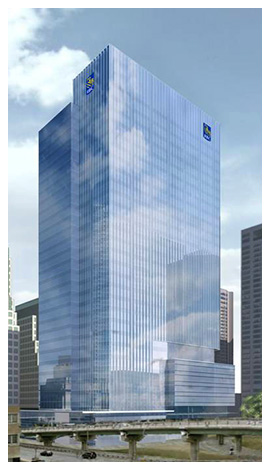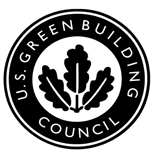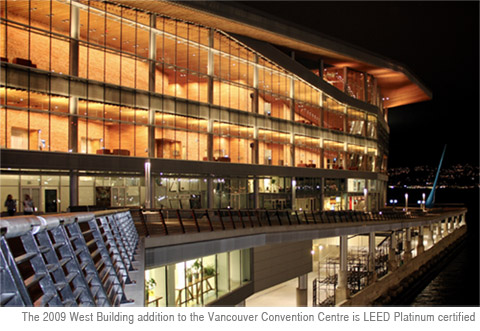The LEED green building rating systems have their fair share of criticism. But what might a better rating system look like? Architect and Founder of the New Urban Guild Steve Mouzon lays out his views with four essential elements.
It was a great idea in the beginning, but the LEED rating systems have become a symbol of all that is wrong with green building today. Getting a LEED rating is slow, difficult, and expensive, and the rating is skewed heavily to “Gizmo Green” solutions that are completely ignorant of where the building is being built, and for whom. We need the opposite sort of system today: one that is intelligent about where a building is built and who it’s being built for, and that is fast, friendly, and free so that anyone can use it.
 The Anti-LEED system (a term I am using for what the new green rating system needs to be) will be smart in four new ways … three about where it is, and the fourth about who it is serving.
The Anti-LEED system (a term I am using for what the new green rating system needs to be) will be smart in four new ways … three about where it is, and the fourth about who it is serving.
First, it must know where in the world it is, as we just discussed, because a highly sustainable building on Cape Cod is ridiculously unsustainable on the Gulf Coast. Once the region is known, it must also know where in the region it is: Is the place being rated in or near a city, town, village, or hamlet? Being green in Toronto is very different from being green in Cheyenne, for example. Once we know that, it’s important to know if the place is in an urban centre, in the suburbs around town, or in the countryside because sustainability on the farm looks very different from sustainability downtown. And finally, it must also know who it is serving, because green building solutions that work for the wealthy almost certainly won’t work for the poor, and vice versa. [Editor—See New RBC Headquarters built by Oxford Properties, expected to be the first LEED Platinum office tower in Toronto]
 If the Anti-LEED system is to be fast, friendly, and free, then its calculations must work very differently from LEED’s. Contrary to common opinion, the U.S. Green Building Council that sponsors the LEED systems is a private company, not a part of the US government. And it reportedly makes most of its money by certifying LEED Accredited Professionals, or LEED-AP, for short. I am one. It is essential that LEED be complicated, otherwise there would be no need for certified professionals to administer it, and the USGBC’s primary money-maker would vanish.
If the Anti-LEED system is to be fast, friendly, and free, then its calculations must work very differently from LEED’s. Contrary to common opinion, the U.S. Green Building Council that sponsors the LEED systems is a private company, not a part of the US government. And it reportedly makes most of its money by certifying LEED Accredited Professionals, or LEED-AP, for short. I am one. It is essential that LEED be complicated, otherwise there would be no need for certified professionals to administer it, and the USGBC’s primary money-maker would vanish.
But it’s not just complicated, it also “hides its eyes” by being point-based, letting a project accumulate points any way it likes and ignoring common-sense things along the way. For example, you can score almost as many points by installing a bike rack as you can by preserving an entire historic building.

It’s also fragmented. The LEED-ND (LEED for Neighborhood Development) system might rate your neighborhood as Platinum while all but turning a blind eye to the true sustainability of the buildings within your neighborhood. And you can build a Platinum house or office in a place that is hideously unsustainable. (See: Ontarians Want More Sustainable Communities)
The Anti-LEED rating system shouldn’t just count points. Instead, it should multiply the “batting average” of the settlement (city, town, village, or hamlet) by that of the neighborhood and by that of the building to finally find out how green a building really is. And it should do most of the calculations “under the hood,” so that someone using the system only needs to take simple measurements. Ideally, a person who knows how to balance their checkbook and do their taxes should be able to rate their building in about an hour.
Those simple measurements, if chosen carefully, can actually be indicators of the performance of complex systems. For example, LEED for Homes is supposed to be simpler than most of the LEED systems. Yet if you want to discover what your credit is for landscape irrigation, it’s 3 pages of relatively complex calculations. The Anti-LEED system should ask one incisive question: “are you using native or well-adapted plants that don’t need long-term irrigation here?” If the answer is “yes,” you get the credit. If not, you don’t.
And now, it’s time for a confession: Maybe Anti-LEED isn’t the best term for what this new green rating system needs to be, because LEED actually works at some of these settings. LEED is designed for Northern regions where it’s important to close up tight and capture the heat efficiently, but looks completely inept in the hot and humid places where I do much of my work. LEED-ND loves cities, tolerates towns, dislikes villages, and hates hamlets. And you’re in good shape if your project is built in the city, but out of luck entirely if you’re building in the country.
Finally, because it’s predisposed to “Gizmo Green” solutions, LEED can work fine for you if you’re really wealthy, but not if you’re middle-class. And if you’re poor, forget it. So let’s put it together: LEED works well if you’re a wealthy person building within a Northern city. But that probably includes about 1% of the world’s population. We need a green building rating system for the rest of us.
This article was first published on Original Green.

[…] corporations are moving their staff into modern green offices in LEED buildings. But the left-behind furniture and equipment often end up in landfill. It’s better to […]
[…] LEED SC Gold, the buildings feature state-of-the-art operating and life safety systems including: […]